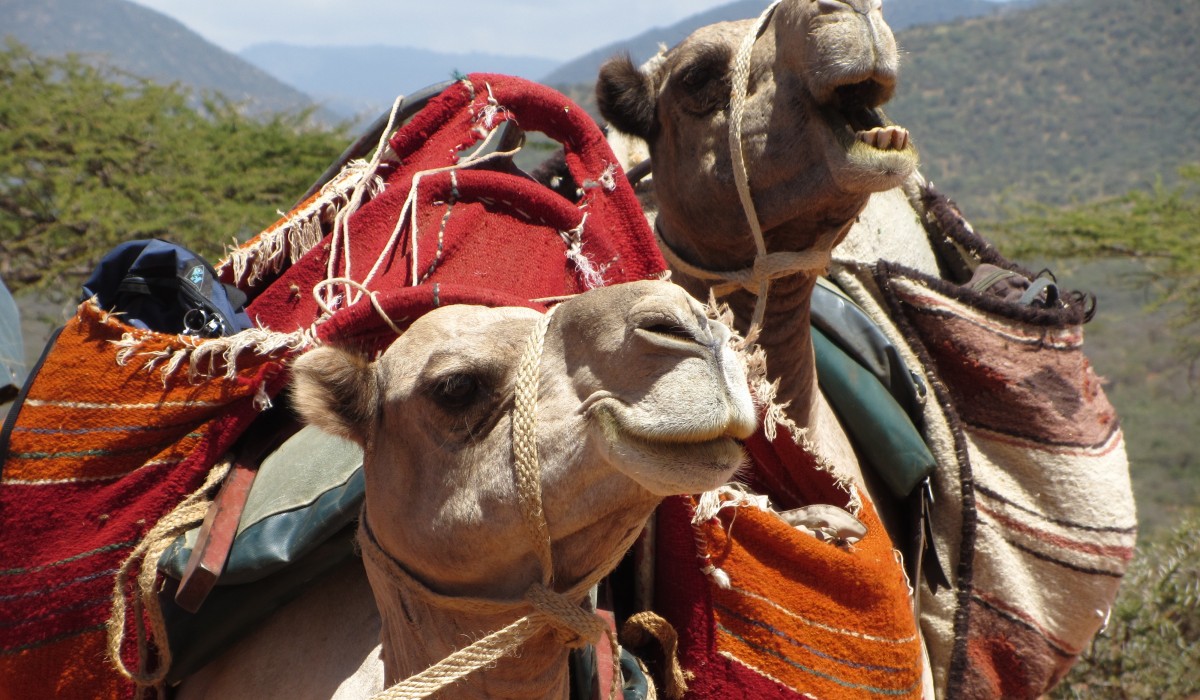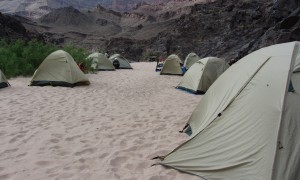by Kate Dernocoeur, guest blogger
They tilt their noses into the air as if peering through bifocals. Their necks kink in a way that would send me scrambling for my chiropractor. They groan, and bawl, and sometimes spit. They burp and fart like nobody’s business.
They fascinate me: camels. They’re strong. Large. Tough. They can cross deserts for days without drinking. Walk placidly on searing-hot sand. Carry 350 pounds (but less is kinder) all day. Rest on their folded legs all night and show no stiffness when they rise in the morning.
I met my first camels in February, when our small plane touched down at the remote airstrip in Kenya’s Northern District. Six of them with their Samburu handlers awaited us, the first of 36 that would haul our safari gear where there are no roads. Even if there were roads, the camels would far more easily tread where truck tires would sink. They are called the “ships of the desert,” because the legs on the same side move forward at the same time. It’s a side-to-side swaying gait that evokes schooners on a rough sea.
What creatures! Camels (often the unfair butt of jokes by the uninitiated) have earned from me the same respect as all large animals, who could easily thrash us humans, but don’t. Our safari camels belong to Kenya-born Helen Douglas-Dufresne, a woman who is passionate about her large herd. For thirty years, camels have been are integral to her Wild Frontiers Kenya safaris . They even carried our day packs—and when necessary, one of us. My ride, for the last 2 kilometers of our six day journey, was just for fun, at the invitation of Helen’s partner and husband, Pete.
The resilience of camels is notorious. The hump—a source of nourishment when food is scarce—consists of fat, not water. Camels easily eat practically anything, including thorns, by the mouthful. These ruminants swallow their food nearly whole, then regurgitate and chew the cud, sending it (finally) to another of several sections of stomach for further processing. When they drink (which isn’t often), they ingest 40 gallons or more. The physiology of this is truly amazing when you consider electrolyte balances, effects of dehydration, and mechanics of heat regulation. I could go on. And on.
My ride on the camel, by the way, was fun! Being ten feet in the air with precious little to hang onto was exciting, and I enjoyed the side-to-side sway. But later that day, when I had the chance to get “up close and personal,” I discovered another thing (and yes, this is unusual for me): camels can be intimidating, the way they can turn their heads on those long necks, snakelike, and reach you even when you think you’re out of range. The sight of their 34 uneven, sharp, prominent teeth was enough to make me stick very close to Helen, who wanders among the herd fearlessly.
I can’t wait to see them again.
Kate spent much of her recent journey in the luggas (dry riverbeds) of Northern Kenya walking beside these remarkable, magnificent creatures, noting the quiet way they walk and enjoying the singing of their Samburu handlers. What a time. The photo of Kate on a camel was taken by safari companion Jerry McAfee.













Comments
4 CommentsPeggydepersia
Apr 17, 2012I loved the opening lines of this posting. What an adventure! Made me wish I’d been there to ‘marvel’ right alongside.
Smith2050
Apr 17, 2012I agree. It’s a great lede. Captured my attention while communicating an image.
Miller Marianne
Apr 18, 2012Enjoy this blog site …a lot….It is known that to Fletcherize your food is a weight control and digestive enhancing practice…those camels and cows are wise.
Vicariously I travel…Thank you wandering bloggers.
Smith2050
Apr 18, 2012Thank you. Glad you can join us. Love your comment.